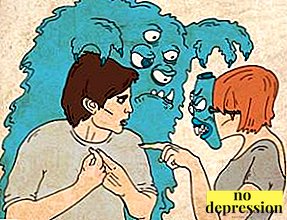At the heart of the series mental disorders lies the phenomenon of "dissociation."
What is it?
Concept

Dissociation - psychological mechanism, consisting in the desire of a person to perceive the situation as if it happens not with him, but with someone else.
The brain dissociates, protecting the psyche from strong emotional turmoil.
The shocks themselves can be like negative (traumatized, unpleasant memories) and positive (too strong positive emotions that cause distress and exhaustion).
Dissociation protects us from blows to the psyche, because there is a confidence that we are absent in this situation. Mind shares and edits memories. Original mental images remain in the subconscious and can emerge in memory if a certain association works.
In everyday life, dissociation can be useful and manifest itself in everyday situations. For example, if you want to evaluate your outfit or behavior from the side.
In the XIX century, the French psychologist Pierre Jeanne He introduced the term "dissociation" (from the Latin dissociatio - "separation, separation"), finding that a part of a person’s ideas can exist outside of his consciousness. However, this idea can be brought back to consciousness through hypnosis.
About dissociation, how about the mechanism of protection of the psyche in this video:
Signs of
 feeling as if the situation was not happening to you;
feeling as if the situation was not happening to you;- distortions of memories;
- the conviction that the feelings you are experiencing do not belong to you;
- the conviction that your feelings are independent and independent of you;
- physical discomfort: headaches, possible pain in parts of the body;
- memory lapses, even amnesia;
- loss of sensation and / or understanding of reality;
- in severe cases, the feeling of leaving the body, separating consciousness from it; as if looking at yourself from the side.
In addition, during dissociation, a person can hear internal voices (conversations of his personalities) and have a tendency to suicide.
Examples
There are many examples of dissociation in humans, from the norm to pathologies. The most striking example is multiple (dissociative) personality disorders, or in a simple split personality.
In this case, while experiencing the traumatic experience, the brain creates a “second personality”, the purpose of which is to taking on this very experience (so that the "primary person" remains safe).

One of the manifestations of “normal” dissociation is the distortion of unpleasant fragments of memories, the suggestion to oneself that the situation did not concern you (did not happen to you), etc.
Fine
Dissociation is normal (or in other words adaptive) is considered first person reaction to stress or strong emotional shock.
When a situation requires concentration and it is necessary to “pull oneself in hands,” for which a person may not be ready, the brain dissociates.
Thus, a person is given the opportunity to temporarily distance himself from emotions, assess his own actions from the outside and make a rational decision.
This mechanism is useful in some cases. but too frequent use dissociation has negative consequences (mainly affects the relationship of a person with society).
So, people with hypersensitivity dissociate in any situations that require emotional involvement. Because of this, it is often difficult for them to build relationships with other people.
Constant dissociation reduces empathy, the ability to assess the emotional side of what is happening. This, in turn, leads to isolation, isolation of the individual.
Permanent dissociations tend mainly to people who have experienced violence or trauma in childhood, when the psyche is especially susceptible.
Pathological

With constant dissociation, the mental health of a person is disturbed.
Disorders from the category of dissociative may develop.
According to research 98% of people they develop in the first years of life or at a young age.
The child dissociates when experiencing painful experience. Emotional contact with one of the parents (usually the mother) can bring him back to normal. If he does not receive due care, temporary dissociation becomes permanent.
Whether it flows into a mental disorder or not depends on a particular person: whether he has a natural susceptibility to disorders, sensitivity is high, how long the traumatic experience lasted, etc.
How to cope with dissociation by tapping? Method of emotional freedom:
Types of dissociative abnormalities
Diagnoses included in ICD-10:
 Dissociative amnesia (F44). The disorder in which the patient loses memories of certain fragments of life (usually unpleasant). At the same time, the ability to perceive new information is retained. The severity ranges from mild (loss of some memories) to severe (deep amnesia). Loss of memory is usually sudden, and the patient is aware of it, consciousness is not disturbed.
Dissociative amnesia (F44). The disorder in which the patient loses memories of certain fragments of life (usually unpleasant). At the same time, the ability to perceive new information is retained. The severity ranges from mild (loss of some memories) to severe (deep amnesia). Loss of memory is usually sudden, and the patient is aware of it, consciousness is not disturbed.- Dissociative fugue (F44.1). Comes from the Latin "fuga" - "escape". The patient purposefully moves to a new place and loses all memories of a past life, including forgetting his biography and name. He may come up with a new one, find another job and at the same time not know that he is sick. The cause of the dissociative fugue can be a serious injury experienced by a person, or a difficult life situation. Thus, the brain creates protection, disconnects from problems.
- The state of trance and possession (F44.3). The state of trance - the connection of the conscious and unconscious state, is accompanied by the activity of certain brain waves (especially beta). When a person falls into a trance purposefully, it is called meditation; in other cases involved in dissociative mental disorders. Obsession is the complete submission of a person’s will to some desire or thought (obsession with an idea). From the point of view of science, is associated with self-hypnosis. In both cases, the ICD-10 disorders are classified as "losing oneself as a person."
Also: dissociative movement disorders, convulsions, loss of sensory perception, personality depersonalization, etc.
 Dissociative identity disorder (F44.81). An uncommon disorder in which a person’s personality is divided into two or more (so-called subpersonalities appear). There are switchings between personalities, that is, at certain moments they replace each other in consciousness. At the same time, they can be of different gender and age, race, character, level of intelligence, etc. As a rule, one of the individuals cannot remember what happened while the other was active.
Dissociative identity disorder (F44.81). An uncommon disorder in which a person’s personality is divided into two or more (so-called subpersonalities appear). There are switchings between personalities, that is, at certain moments they replace each other in consciousness. At the same time, they can be of different gender and age, race, character, level of intelligence, etc. As a rule, one of the individuals cannot remember what happened while the other was active.It is the most extreme manifestation of dissociation. It usually occurs in early childhood due to the experienced violence and severe stresses.
Symptoms combines dissociative amnesia, fugu, depersonalization, etc. For a long time, the existence of this disorder has been questioned.
Usually the dissociative fugue lasts for several hours or months, and after its termination the patient remembers the past life, but forgets everything that happened during the fugue.
Dissociative disorder - split personality. About the causes and methods of treatment in this video:
Association and dissociation

In addition to dissociation, there is also an association. it different types of perception of situations.
If, in the case of dissociation, I mean “I am disconnected, I look with other people's eyes,” then when I associate it the other way round is “I get involved in the situation as much as possible”.
The association allows us to be in a situation, to feel it as if from the inside, to participate directly. Dissociation allows pull away.
The association is “my actions”, the dissociation is “my assessment of my own actions”.
We have already said that dissociation allows us to soften the perception of unpleasant situations. Association is the opposite gives us access to emotions experienced inside the situation.
We associate when we recall pleasant fragments in which we participated (memory of a birthday, a trip to somewhere, etc.).
The association is partly associated with empathy. Thanks to her we can associate ourselves with another person, understand his motives, intentions of action. This happens, for example, when we cry over a sad episode of a film or parody another person.
Both of these perceptions are useful in mild and rare manifestations.
In conclusion, it can be said that moderately dissociating is normal and even useful to some extent. But if symptoms of frustration or permanent dissociation occur, contact a psychiatrist.
Association-dissociation. How to get rid of negative experiences? Find out from the video:

 feeling as if the situation was not happening to you;
feeling as if the situation was not happening to you; Dissociative amnesia (F44). The disorder in which the patient loses memories of certain fragments of life (usually unpleasant). At the same time, the ability to perceive new information is retained. The severity ranges from mild (loss of some memories) to severe (deep amnesia). Loss of memory is usually sudden, and the patient is aware of it, consciousness is not disturbed.
Dissociative amnesia (F44). The disorder in which the patient loses memories of certain fragments of life (usually unpleasant). At the same time, the ability to perceive new information is retained. The severity ranges from mild (loss of some memories) to severe (deep amnesia). Loss of memory is usually sudden, and the patient is aware of it, consciousness is not disturbed. Dissociative identity disorder (F44.81). An uncommon disorder in which a person’s personality is divided into two or more (so-called subpersonalities appear). There are switchings between personalities, that is, at certain moments they replace each other in consciousness. At the same time, they can be of different gender and age, race, character, level of intelligence, etc. As a rule, one of the individuals cannot remember what happened while the other was active.
Dissociative identity disorder (F44.81). An uncommon disorder in which a person’s personality is divided into two or more (so-called subpersonalities appear). There are switchings between personalities, that is, at certain moments they replace each other in consciousness. At the same time, they can be of different gender and age, race, character, level of intelligence, etc. As a rule, one of the individuals cannot remember what happened while the other was active.

